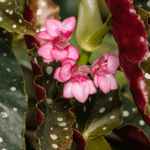
Calathea ornata, also known as pinstripe plant or pinstripe calathea, is a tropical houseplant with gorgeous, striped foliage. It needs high humidity, proper lighting, and moist soil to grow well. In this post, I’ll cover all the reasons your calathea might not be thriving (and offer solutions).
Why is my Calathea ornata dying? The most common causes are low humidity, excessive fertilizer, hard or fluoridated water, dry soil, or too much sunlight. Pinstripe plant is also prone to spider mites, which can cause rapid decline. Let’s take a closer look at these issues, including how to fix them and bring your plant back to health.
Low Humidity
The most common reason for Calathea ornata dying is low humidity. As a tropical plant, it requires high humidity levels (60 percent or above in winter) to thrive. This can be difficult to achieve if you live in a dry climate or if you have a centrally heated home in winter.
If leaves are turning brown, this typically indicates humidity levels are too low. If you notice your Calathea dying in winter, low humidity could also be the culprit, as air dries out more when heaters are running. Here are some ways to increase humidity:
- Place plant on a humidity tray (a shallow, water-tight tray filled with pebbles and water), and/or place close to other plants with high humidity requirements.
- Mist the plant regularly using a spray bottle filled with tepid filtered or distilled water. Mist daily if air is extremely dry or a few times a week in moderately dry conditions.
- Place a high-quality houseplant humidifier in the room near your plant. If you don’t have a humidifier or can’t reasonably obtain one, see my post on how to increase humidity for plants without a humidifier.
Excessive Fertilizer
Another possible cause of Calathea ornata dying is excessive fertilizer. This plant is very sensitive to built up fertilizer salts in the soil. Even if you aren’t fertilizing excessively, the salts can still build up over time and cause problems. It’s a good idea to leach your pots periodically.
Leaf tips and edges turning brown can be a sign of excessive fertilizer or fertilizer salts in the soil. If you aren’t sure, you won’t hurt anything by leaching the pot your Calathea is growing in. (Don’t be afraid to try it.) Here’s what to do:
- Place your plant in a large sink or tub (or outside somewhere you can flush it out).
- Water thoroughly with clean, tepid water. Do not use tap water that contains fluoride on Calathea ornata. Water with filtered, distilled, or naturally obtained water only.
- Allow excess water to drip out through the drainage holes for at least 30 minutes, then water thoroughly a second time.
- Repeat once more (for a total of three flushes). Once the water is completely drained, move the plant back to its regular location. If your pot sits on a tray, make sure to pour off any excess water that’s accumulated there.
Hard or Fluoridated Water
Just as Calathea ornata is sensitive to fertilizer salts, it’s also sensitive to hard water and chemicals in tap water – particularly fluoride and chlorine. If you water with hard or tap water, your plant’s leave may start turning yellow or brown as they basically get a “chemical burn.”
Switch to using only filtered, distilled, spring, or even rain water on your Calathea ornata. If you don’t have a water filter system in your home, just place a bowl or bucket outside when it rains to collect rain water. Then, use this as a primary water source for your plant.
Dry Soil (Under-Watering)
Calathea ornata will not perform well if the soil is allowed to dry out. It needs lightly moist soil at all times. This can be difficult to achieve without over-watering, but you have to learn to strike the delicate balance between under-watering and watering too much.
For the best results, water any time the top of the potting soil becomes dry to a depth of 0.5 inches (1.27 cm). To test soil moisture, insert your finger into the soil up to 1/2-inch. If it feels dry, water the plant immediately. If it still feels moist, you can wait another day.
Too Much Sunlight
Too much sunlight is another way you can kill Calathea ornata. This tropical plant is native to the rain forest floor, where it receives bright, indirect light. Avoid direct sun, which will burn pinstripe plant’s delicate leaves.
Leaves turning yellow is often an indication of too much sunlight. Direct light burns and “bleaches” the leaves, causing them to turn yellow and drop off. You can save your plant by immediately moving to a location that does not get direct sun.
The ideal location for this plant is an east-facing window with the light filtered by gauzy curtains. You can also place it a few feet back from a west-facing window, or several feet back from a south-facing window. Calathea ornata also grows well under artificial plant lights.
Spider Mites
And finally, your Calathea ornata might be dying due to spider mites. This plant is prone to infestation if high humidity is not maintained. Signs include yellow, speckled leaves with sticky undersides. A light webbing may also be seen around and between the leaves.

It’s very important to catch and treat a spider mite infestation at the earliest possible stage. If you see webbing on the leaves, the infestation is very advanced and there’s no saving the plant. You’ll just have to discard it completely. If you catch it early enough, you can try a pesticide or miticide (like Crop Control).
Why is My Calathea Ornata Dying?
There are numerous reasons why your Calathea ornata might be dying. The most common reason is low humidity. But if you have that under control, check for excessive fertilizer or build up of fertilizer salts in the soil. Leach pots regularly to prevent root damage from build-up.
Make sure you aren’t using tap water to water your plant, and water often enough to keep soil consistently moist. Chemicals in tap water and under-watering are major causes of poor performance. Avoid direct sunlight, which burn’s the plant’s leaves. And finally, check for a spider mite infestation, and treat it as soon as possible if present.
Related Questions
Here are some frequently asked questions related to “Calathea ornata dying” that you might find helpful (and my answers to them).
Why is my Calathea Turning Yellow? Watering Calathea with tap water is the most likely cause of yellowing leaves. The plant is very sensitive to fluoride, chlorine, and other chemicals found in tap water. It’s also sensitive to hard water. Switch to using filtered, distilled, or even rain water to get your plant back to health.
How do You Revive a Dying Calathea? First figure out what’s causing the plant to decline, then make the necessary adjustments. Increase humidity, reduce the amount of fertilizer you give the plant, leach pots to remove built-up fertilizer salts, switch to filtered or distilled water instead of tap water, and make sure the plant is not getting direct sunlight. You may not need to perform all these steps, depending on your circumstances.
Should I Cut Dead Leaves Off Calathea? Yes, you should remove any dead or dying leaves at the base of the stem. Yellow or brown leaves are safe to remove. If only the leaf tips or edges are brown, don’t remove the entire leaf. However, if it bothers you, use sharp pruning shears to cut off the damaged edges only, leaving the healthy green parts of the leaf on the plant.




